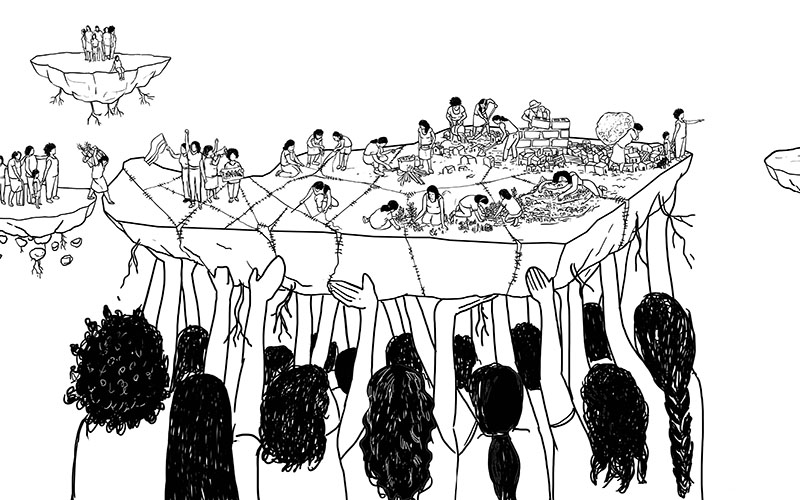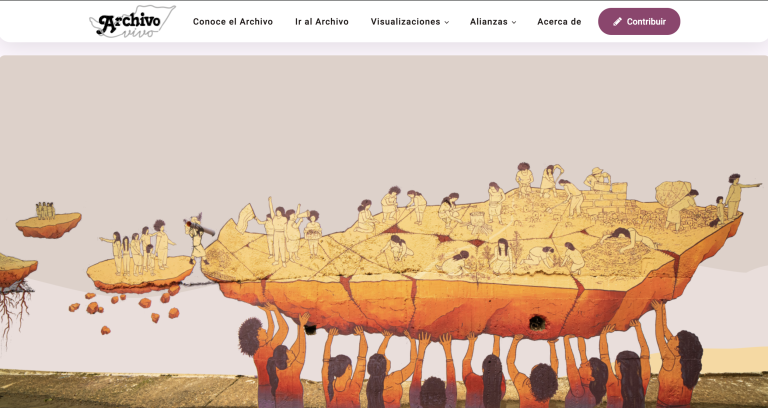Living Archives [Archivo Vivo]: Weaving gendered (hi)stories of Territorial Reclamation
A collaborative research-based design project that seeks to recognise practices of urban reclamation, led by women in Moravia, Medellin (Col).

18 January 2024
Living Archives [Archivo vivo]: Weaving gendered (hi)stories of Territorial Reclamation is a collaborative research-based design project that seeks to recognise practices of urban reclamation, led by women in Moravia, Medellin (Col). Moravia is a neighbourhood of ‘migrants' in constraint flux and originated in the 70’s as a by-product of forced displacements, the violence of war and social injustices still facing ongoing threats of eviction. Archivo Vivo is a collaborative project that documents stories of territorial reclamation in Moravia (Medellín, Colombia). It focuses on the living heritage of the city, which is constituted by processes of community organisation and neighbourhood self-construction. Archival processes involve multiple forms of recording who we are and what we do. This project seeks to recognise practices of urban reclamation led by women as part of the living archive of Moravia. The collaboration was guided by the following questions:
How can we recognise the practices of territorial reclamation led by the women as part of the living archive of Moravia?
- What socio-spatial practices constitute the living archive of Moravia?
- How does weaving socio-spatial strategies to imagine urban futures for Moravia promote the permanence of the inhabitants?
- How can we communicate and make Moravia's living archive visible as a reparation tool?
Image credits: RedtinaLab
- Approach
Using a living archive approach, we engage in co-creation processes focused on revealing processes and practices of memory transmission and future envisioning in Moravia. Together with our partners, we challenged narratives about stigmatised communities and places while engaging in creative yet critical responses to the present and exposing alternative paths to the future. We used living archives as a decolonial methodology to re-centre life to imagine forms of living heritage based on relational forms of thinking and being. This approach allowed us to include textile practices, social cartographies, audio-visual material, historical photos, maps, and everyday interactions that capture the polyphony of (hi)stories and the multiplicity of spatial practices often silenced. This work aims to contribute to the processes of social mobilisation, territorial agreements, and community learning.
The project proposed two intertwined strategies of co-creation: gendering the archive and weaving (hi)stories of reclamation to reframe a repository of urban memory and living heritage into a process of collective imagination to counteract the existing enduring eviction threats. In Moravia, living archives have been crucial in mobilising women's emancipatory transformation and as artefacts for advocacy. Our project focuses on the living heritage of the city, which is constituted by processes of community organisation and neighbourhood self-construction. We agreed to focus on three issues that are at the heart of the territory's historical and current claims for the right to the city: security of tenure, ‘reception’ of migrants and ecological reparations. Through processes of co-creation, we found that living archives 1) are inscribed in bodies, self-built urban spaces, and collective reclamation practices, 2) can help to spacialise our emotions to bridge connections with our past in the present, triggering processes of territorial healing (Ortiz & Gómez-Córdoba, 2023) and 3 ) represent a call for collective actions that observe, recognise and appreciate the territory as an ‘affective infrastructure of knowledge co-production’ (Ortiz et al., 2022). Through a living archive, communities establish multi-temporal conversations about their connections to the territory, to reveal everyday interactions, the polyphony of histories and the multiplicity of often silenced spatial practices.
- Team
Archivo Vivo de Moravia is a project coordinated by Catalina Ortiz, DPU, University College London & Natalia Villamizar Duarte, School of Architecture, Planning and Landscape, Newcastle University, Luz Mila Hernandez, Moravia Resiste, and Monica Saldarriaga, Centro de Desarrollo Cultural de Moravia.
The learning alliance have been integrated by scholars and students of the MSc Building and Urban Design in Development from DPU, University College London, scholars from Newcastle University (2023), the team of the Centro de Desarrollo Cultural de Moravia (CDCM), Planearte SAS, members of the various community organisations in Moravia such as Moravia Resiste, JARUM, Fundación Oasis Tropical, Colectivo TriciLab, Mama Chila Tours, and the Red Cultural Comuna 4.
The project was funded by the 2nd round of commissioned projects of “Imagining Futures Through Un/Archived Pasts" led by the University of Exeter and sponsored by AHRC- GCRF.
- Outputs
Digital repository
The digital repository includes over 600 records about the neighbourhood. To launch this repository the community organisations in Moravia have proposed activities of spatial activation that are intended to bring the repository closer to the communities and the territory.
Visit the Archivo Vivo de Moravia website.
Report Living Archive Moravia 2023This report entitled “Living Archive: Weaving Gendered (Hi)stories of Territorial Reclamation in Moravia, Medellin”, documents myriad ways to frame a living archive departing from the exchange that took place in Medellin and involved diverse community members and community organisations in Moravia.
Archivo vivo Mural by Dubián Monsalve
A key output of this project is the Mural Archivo Vivo designed by local artist Dubián Monsalve after a long process of engagement with diverse participants in the Medellin exchange. This mural captures the processes of the engagement but more importantly the essence of the role of women in the processes of occupation and transformation of Moravia. Images of this piece are available here.
Parque de las Canillas Mural by La Jefa
One of the processes of spatial co-creation carried out during the Medellin exchange took place in the Canillas Park’s where we collaborated with the local artist La Jefa to memorialise the role women in Moravia and particularly in this place. Before Moravia had water infrastructure in homes, Canillas Park was where people, particularly women came to collect water and clean their clothes (Report Living Archive Moravia 2023, English version, p.106).
Exhibition and open dialogue ‘tejiendo barrio’!
This event brought together four groups of community weavers to open a dialogue about the role of weaving in memory transmission and processes of reparations. The exhibition, which was open to the public for two weeks in the Centro de Desarrollo Cultural de Moravia, included pieces created by women in these four community groups. This process was documented here.
Videos produced by Tricilab
The processes of co-creation that took place in Medellin during the exchange was documented in 4 videos, one video that summarises the whole process and three videos focusing on three thematic lenses identified in the theoretical framework of the project.
 Close
Close

